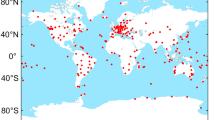Abstract
For airborne radar, there are usually insufficient independent and identically distributed (IID) training data because of geometric considerations and terrain variations. The rank reduction technique is one of the most effective approaches to circumvent this problem. In this study, we investigate four reduced-rank spacetime adaptive detectors for airborne radar, namely, the reduced-rank sample-matrix-inversion (RR-SMI), the reduced-rank adaptive matched filter (RR-AMF), the reduced-rank adaptive coherence estimator (RR-ACE), and the reduced-rank generalized likelihood ratio test (RR-GLRT). Their asymptotic analytical probabilities of detection (PD’s) and false alarm (PFA’s) are all derived. These detectors all asymptotically attain a constant false alarm rate (CFAR). It is shown that these four reduced-rank detectors exhibit detection performance which is better than or comparable to that of two existing reduced-rank detectors, proposed by Reed and Gau (RG1 and RG2). Moreover, these four reduced-rank detectors are more robust to change in power of clutter and noise than RG1 and RG2.
Similar content being viewed by others
References
Guerci J R, Bergin J S. Principal components, covariance matrix tapers, and the subspace leakage problem. IEEE Trans Aerospace Electron Syst, 2002, 38: 152–162
Duan K Q, Xie W C, Wang Y L. Nonstationary clutter suppression for airborne conformal array radar. Sci China Inf Sci, 2011, 54: 2170–2177
Wu R B, Jia Q Q, Li H. A novel STAP method for the detection of fast air moving targets from high speed platform. Sci China Inf Sci, 2012, 55: 1259–1269
Gong W F, Sun X. An improved reduced-rank stap interference suppression method in design of GNSS receivers. Sci China Inf Sci, 2012, 55: 2329–2342
Wang Y L, Chen J W, Bao Z, et al. Robust space-time adaptive processing for airborne radar in nonhomogeneous clutter environments. IEEE Trans Aerospace Electron Syst, 2003, 39: 70–81
Reed I S, Gau Y L. A fast CFAR detection space-time adaptive processing algorithm. IEEE Trans Signal Process, 1999, 47: 1151–1154
Gau Y L, Reed I S. An improved reduced-rank CFAR space-time adaptive radar detection algorithm. IEEE Trans Signal Process, 1998, 46: 2139–2146
Haimovich A. The eigencanceler: adaptive radar by eigenanalysis methods. IEEE Trans Aerospace Electron Syst, 1996, 32: 532–542
Goldstein J S, Reed I S. Theory of partially adaptive radar. IEEE Trans Aerospace Electron Syst, 1997, 33: 1309–1325
Zhuang X B, Cui X W, Lu M Q, et al. Numerically stable method of signal subspace estimation based on multistage Wiener filter. Sci China Inf Sci, 2010, 53: 2620–2630
Ren P, Wang R, Zhang S. Rectangle blocking matrices based unitary multistage wiener reduced-rank joint detection algorithm for multiple input multiple output systems. Sci China Inf Sci, 2010, 53: 2116–2126
Goldstein J S, Reed I S, Scharf L L. A multistage representation of the wiener filter based on orthogonal projections. IEEE Trans Inform Theory, 1998, 44: 2943–2959
Pados D A, Batalama S N. Joint space-time auxiliary-vector filtering for ds/cdma systems with antenna arrays. IEEE Trans Commun, 1999, 47: 1406–1415
Fa R, de Lamare R C. Reduced-rank STAP algorithms using joint iterative optimization of filters. IEEE Trans Aerospace Electron Syst, 2011, 47: 1668–1684
Wang L, de Lamare R C. Adaptive constrained constant modulus algorithm based on auxiliary vector filtering for beamforming. IEEE Trans Signal Process, 2010, 58: 5408–5413
Santos E L, Zoltowski M D, Rangaswamy M. Indirect dominant mode rejection: a solution to low sample support beamforming. IEEE Trans Signal Process, 2007, 55: 3283–3293
Guerci J R, Goldstein J S, Reed I S. Optimal and adaptive reduced-rank STAP. IEEE Trans Aerospace Electron Syst, 2000, 36: 647–663
Ward J. Space-Time Adaptive Processing for Airborne Radar. Technical Report, Lincoln Lab, Lexington. 1994
Reed I S, Mallett J D, Brennan L E. Rapid convergence rate in adaptive arrays. IEEE Trans Aerospace Electron Syst, 1974, AES-10: 853–863
Chen W S, Reed I S. A new CFAR detection test for radar. Digit Signal Process, 1991, 1: 198–214
Robey F C, Fuhrmann D R, Kelly E J, et al. A CFAR adaptive matched filter detector. IEEE Trans Aerospace Electron Syst, 1992, 28: 208–216
Kraut S, Scharf L L. The CFAR adaptive subspace detector is a scale-invariant GLRT. IEEE Trans Signal Process, 1999, 47: 2538–2541
Kelly E J. An adaptive detection algorithm. IEEE Trans Aerospace Electron Syst, 1986, AES-22: 115–127
Liu W, Xie W, Wang Y. Diagonally loaded space-time adaptive detection. In: Proceedings of IEEE International Conference on Radar, Chengdu, 2011. 1115–1119
Haimovich A M, Berin M. Eigenanalysis-based space-time adaptive radar: performance analysis. IEEE Trans Aerospace Electron Syst, 1997, 33: 1170–1179
Ayoub T F, Haimovich A R. Modified GLRT signal detection algorithm. IEEE Trans Aerospace Electron Syst, 2000, 36: 810–818
Gau Y L. CFAR Detection Algorithms for STAP Airborne Radar. University of Southern California, Ph.D. Dissertation. University of Southern California, 1996
Liu W J, Xie W C, Wang Y L. AMF and ACE detectors based on diagonal loading. J Syst Eng Electron, 2013, 35: 463–468
Liu W J, Xie W C, Wang Y L. Some complex statistical distributions in complex-valued signal detection theory. Acta Electron Sinica, 2013, 41: 1238–1241
Kelly E J, Forsythe K M. Adaptive Detection and Parameter Estimation for Multidimensional Signal Models. Technical Report, Lincoln Lab, Lexington. 1989
Kirsteins I P, Tufts D W. Rapidly adaptive nulling of interference. High Resolution Methods in Underwater Acoustics. Berlin Heidelberg: Springer, 1991. 220–249
Scharf L L, Friedlander B. Matched subspace detectors. IEEE Trans Signal Process, 1994, 42: 2146–2157
Author information
Authors and Affiliations
Corresponding author
Electronic supplementary material
Rights and permissions
About this article
Cite this article
Wang, Y., Liu, W., Xie, W. et al. Reduced-rank space-time adaptive detection for airborne radar. Sci. China Inf. Sci. 57, 1–11 (2014). https://doi.org/10.1007/s11432-013-4984-5
Received:
Accepted:
Published:
Issue Date:
DOI: https://doi.org/10.1007/s11432-013-4984-5




